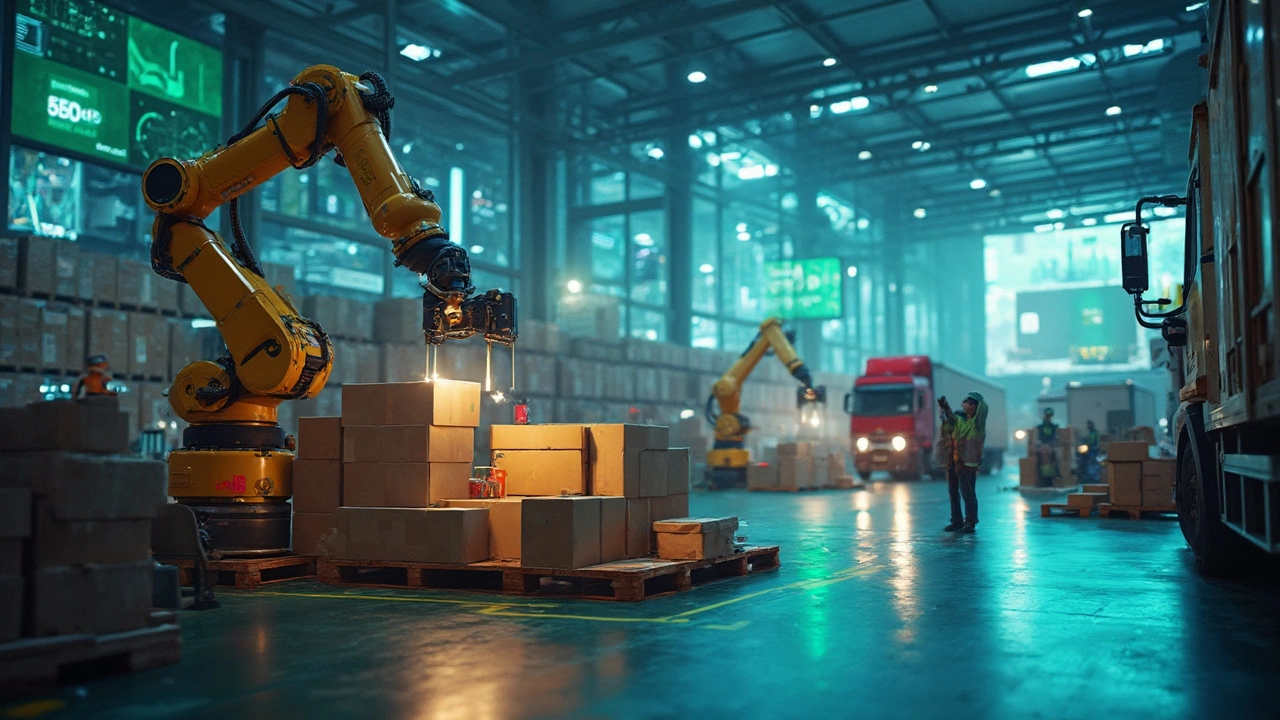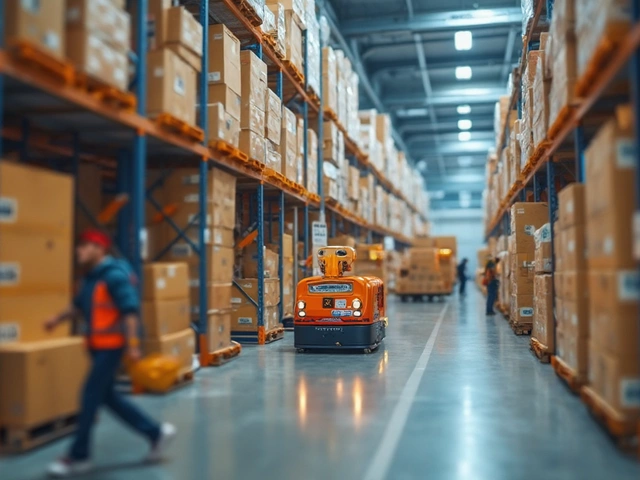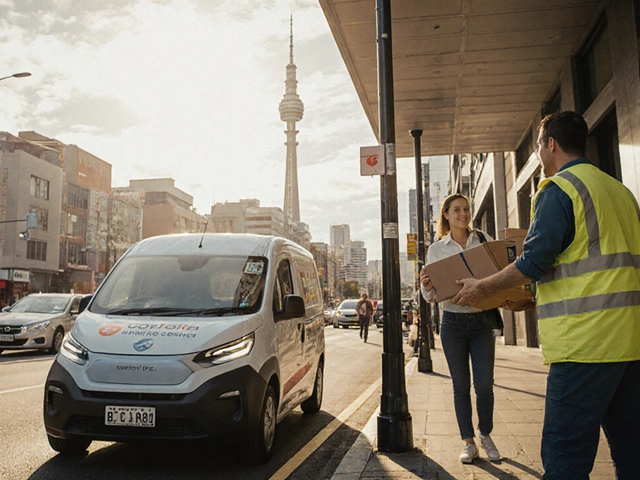Ever wonder how logistics – the unsung hero behind your online shopping spree – rakes in the big bucks? Let's break it down into bite-sized pieces. When your favorite e-store promises delivery in two days, it's the logistics wizards working behind the curtain to make sure your package arrives on time. They make sure every step, from picking and packing in warehouses to shipping and delivery, is as smooth as possible.
But how do these companies turn a profit? One word: efficiency. They streamline operations to cut costs and improve delivery times. By optimizing their supply chains, they're saving money and ensuring you can track your order in real-time. Plus, they've got the last-mile delivery – the final sprint of the race to your doorstep – down to a science, which is crucial in the fast-paced world of e-commerce.
- The Role of Logistics in E-commerce
- Crucial Elements Making Money
- Optimizing Supply Chains
- The Magic of Last-Mile Delivery
- Technology's Impact on Logistics
- Tips for Businesses to Boost Logistics Revenue
The Role of Logistics in E-commerce
Logistics is like the backbone for any thriving e-commerce business. You know, without it, getting products from site to doorstep would be a nightmare. It’s not just about moving stuff around; it's more about doing it in the best way possible - fast and cost-effective.
Why does this matter? Well, logistics directly affect customer satisfaction. Imagine ordering something online and waiting weeks for it to arrive. Doesn't sound good, right? That's where logistics shines. By managing inventory, processing orders efficiently, and ensuring timely deliveries, it keeps customers happy and businesses profitable.
The Supply Chain Connection
The supply chain, a network from suppliers to warehouses to the final destination, plays a massive part. A well-oiled supply chain ensures that the right products are available at the right time. When inventory management is on point, e-commerce companies can avoid stockouts or overstocking – both of which can cost money.
Improving Delivery Capabilities
The delivery is a big deal. Many experts consider last-mile delivery when discussing fast and reliable shipping. Enhancing delivery capabilities, for instance through route optimization and partnerships with local delivery services, is crucial for meeting customer expectations.
Logistics Challenges and Solutions
But it’s not all sunshine and rainbows. Logistics faces challenges like high shipping costs and unexpected delays. Solutions often involve technology, like automated systems and real-time tracking, to mitigate these issues, making the process more transparent and efficient.
In a nutshell, logistics isn't just moving products. It's about doing it smarter. It’s about boosting e-commerce with reliability, speed, and efficiency, ensuring customers get their goodies without a hitch.
Crucial Elements Making Money
So, how does the magic happen? What are the crucial elements that help logistics in e-commerce rack up revenue?
Inventory Management
First things first: inventory management. Keeping track of what's in stock and where it’s located is key. Inventory systems use smart software to predict demand, reduce overstock, and avoid running out of popular items. It’s all about balance. The goal is to minimize storage costs while maximizing order fulfillment.
Efficient Transportation
Transport is a biggie, and it's not just about trucks. Airlines, ships, and trains all play a part in the global logistics dance. Companies optimize routes and choose the most cost-effective and time-efficient modes of transport. Pro tip: shipping in bulk can save money.
Freight Negotiation
Negotiating freight rates is basically an art. By striking deals with carriers, logistics companies lock in rates that keep costs down. Long-term partnerships can mean better rates and priority treatment, translating into savings that boost the bottom line.
| Element | Impact |
|---|---|
| Inventory Management | Reduces costs, avoids overstock |
| Transportation | Optimizes delivery, reduces time |
| Freight Negotiation | Lowers shipping costs, increases profit margin |
Last-Mile Delivery
The last mile can make or break the customer experience. Investing in local delivery networks can speed up this crucial phase. Some companies even use local workers or gig economy drivers to stay flexible and cost-effective. Think of it as saving time and money while making customers happy.
Technology Integration
Tech is your friend here. Using robust data analytics helps with predicting trends and optimizing routes. Automation, like drones and smart warehouses, can also shave time off processes and reduce errors, which adds to the bottom line.
In a nutshell, these key elements, when executed well, make logistics a profitable game in e-commerce. It's all about tightening the screws on efficiency while keeping a keen eye on costs.
Optimizing Supply Chains
In the world of e-commerce, having an optimized supply chain is like having the secret recipe to a successful dish. It's all about getting products from point A to point B as smoothly and cost-effectively as possible. Successful supply chains blend various operations, manufacturers, and processes into a single, seamless system. How do they do this? Let's break it down.
Streamlined Processes
First things first, streamline those processes! By simplifying each step – from sourcing materials to delivering finished products – logistics companies can cut unnecessary costs and time wastage. This often involves automating repetitive tasks, such as inventory checks, to minimize human error and free up valuable time for employees.
Demand Forecasting
Imagine trying to guess how many umbrellas you’ll sell during monsoon season. Sounds tricky, right? That's where demand forecasting comes in. By analyzing past sales data and market trends, companies can predict their inventory needs with surprising accuracy. This reduces waste and stock outages, keeping customers happy and profits steady.
The Power of Collaboration
Ever heard the saying, "Two heads are better than one"? Well, it applies here too. Many logistics companies team up with other businesses and experts to share resources and expertise. This collaboration often leads to reduced costs and improved efficiency – a win-win! Just imagine a tech company partnering with a delivery service to refine its last-mile delivery process.
Technology - The Game Changer
It's the digital age, and technology’s impact on logistics is undeniable. Advanced tools and software now allow for instant access to data at every stage of the supply chain. This means companies can spot bottlenecks and inefficiencies quickly, responding in real-time to keep things running smoothly.
Let's take a peek at some eye-opening stats in the table below:
| E-commerce Efficiency Gain | Percentage |
|---|---|
| Automation | 25% |
| Demand Forecasting Accuracy | 20% |
| Collaboration Benefits | 15% |
Optimizing the supply chain is crucial because it’s not just about cutting costs and saving time. It's about making sure every player in the game, from manufacturers to end consumers, gets maximum value. When done well, it’s a strategic advantage that keeps businesses ahead of the curve – and keeps customers coming back for more.

The Magic of Last-Mile Delivery
In the world of e-commerce, the final stretch of getting a package from the delivery hub to your front door is what we call the 'last-mile delivery.' It's a big deal because it's the step where everything can go right or disastrously wrong. Ever had a package mysteriously disappear or arrive way later than expected? Yeah, that's a last-mile hiccup.
Why is it called magic, you ask? Well, this is the stage where logistics companies truly show off their skills. The main challenge here is the variety of destinations. Deliveries have to navigate crowded city streets, secluded rural areas, and everything in between. That's why companies invest heavily in creating efficient last-mile systems. And let's face it, speedy delivery equals happy customers – and that's great for business!
Key Strategies for Success
To ace this essential part, businesses rely on several smart strategies:
- Route Optimization: By using clever algorithms and GPS technology, logistics firms can find the best routes, saving time and cutting down fuel costs.
- Local Warehousing: Placing inventory closer to customers. This reduces travel time and boosts delivery speed.
- Delivery Drones and Robots: It sounds futuristic, but it's happening. These can tackle areas that are hard for humans to reach and speed up the process.
Beat the Traffic with Technology
Technology is the last-mile delivery's best friend. From real-time tracking to automated notifications, tech helps firms keep customers in the loop and super satisfied.
| Year | Last-Mile Delivery Market Value (in Billion USD) |
|---|---|
| 2021 | 108 |
| 2023 | 135 |
| 2025 | 181 (Projected) |
The table above shows how much the last-mile delivery market has grown over the years. This boom is a testament to its importance in the wider logistics landscape.
When done right, last-mile delivery isn't just the end of the supply chain; it's the icing on the e-commerce cake. And it's no wonder logistics companies are continuously innovating to keep it magical.
Technology's Impact on Logistics
Do you know that technology is the backbone of modern logistics? It revolutionizes how businesses handle e-commerce orders, moving packages from warehouses to your front door like magic. But it's not magic – it's data, automation, and smart systems at work!
One significant advancement is the use of real-time tracking systems. These systems give businesses and customers regular updates on orders. They help logistics companies maximize efficiency and transparency. So, if you ever checked your delivery status, thank tech for making that possible!
Automation in Warehouses
Automation takes logistics to new heights by boosting efficiency in warehouses. Robots and automated systems speed up picking and packing, cutting down human error and labor costs. Imagine robots zooming around, picking up your order and getting it ready for shipment. That's the future, and it's here now. Many big players like Amazon have automated distribution centers, slashing the time it takes to process orders.
Using Data for Smart Decisions
Logistics companies also dig deep into data to make smarter decisions. Predictive analytics help anticipate demand, optimize routes, and manage inventories. By understanding patterns and trends, businesses save on costs and prevent delays. It's like having a crystal ball that guides stock levels and delivery schedules.
The Internet of Things (IoT) Revolution
Another tech breakthrough is IoT, where everyday devices connect to the internet. In logistics, IoT helps with monitoring storage conditions and tracking assets. Sensors can alert managers if temperatures spike or if shipments face delays. IoT keeps the supply chain robust and adaptable, essential for the fast-paced world of e-commerce.
- IoT sensors reduce spoilage by 30% in temperature-sensitive goods.
- Real-time tracking boosts customer satisfaction by over 20%.
Increased connectivity, automation, and advanced data analytics are all crucial elements transforming the logistics landscape. As technology evolves, the impact on logistics continues to reshape how efficiently and effectively goods are delivered, ultimately driving more revenue for businesses.
Tips for Businesses to Boost Logistics Revenue
Boosting revenue in logistics doesn’t have to be rocket science. It's about identifying opportunities and seizing them. Let's look into some practical tips that businesses can use to enhance their logistics revenue.
1. Embrace Technology
Technology is the backbone of efficient logistics operations. Leveraging tools like AI for data analysis and predictive logistics can help businesses optimize routes and reduce delivery times. This not only saves money but also improves customer satisfaction. Consider implementing a real-time tracking system, which not only boosts transparency but can also be a selling point for customers looking for reliability.
2. Optimize Inventory Management
Keeping a tight rein on inventory is crucial. By utilizing just-in-time inventory practices, businesses can decrease holding costs. Smart inventory management systems can predict demand patterns, ensuring that you’re never overstocked or facing unexpected shortages.
3. Focus on Sustainable Practices
Sustainability isn't just a buzzword. More and more consumers value eco-friendly practices. By optimizing delivery routes and reducing packaging waste, not only do you help the environment, but you also appeal to a growing segment of environmentally-conscious customers. This can lead to increased loyalty and potentially, increased sales.
4. Enhance Last-Mile Delivery
Last-mile delivery is often the most costly part of the supply chain. Streamlining this process can significantly impact your bottom line. Consider options like crowdsourced delivery or local micro-warehouses to cut down on delivery times and costs.
5. Build Strong Partnerships
Forming alliances with other businesses can lead to cooperative route planning and shared resources, which can cut costs and improve delivery times. It's a win-win situation, providing both parties with increased market reach and efficiency.
6. Invest in Staff Training
Your team is your greatest asset. Properly trained employees are more efficient, make fewer mistakes, and can adapt to technology changes more smoothly. Regular training sessions can ensure that your staff stays up-to-date with the latest logistics practices.
By implementing these tips, businesses can enhance their logistics operations, leading to more revenue and happier customers. Remember, in the e-commerce world, efficiency and customer satisfaction go hand in hand.





